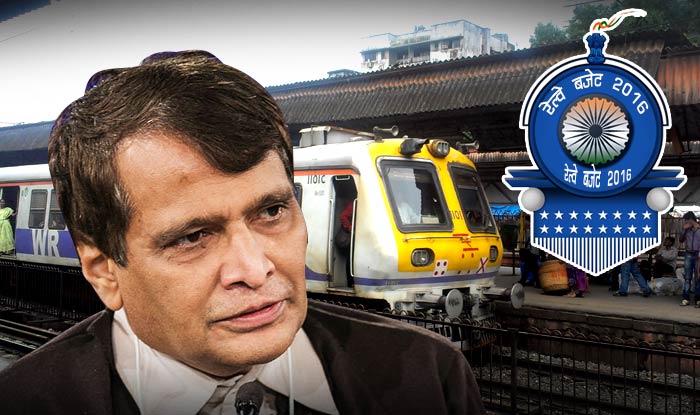
SALIENT FEATURES
- No hike in passenger fare
- 65,000 additional berths and 17,000 bio toilets to be installed
- Operations audit to improve punctuality of trains proposed
- Stations to be developed under PPP mode
- Award of civil contracts for dedicated freight corridor to be over by the end of this financial year
- Capacity of e-ticketing system to be enhanced
- Increased quota of lower berth for senior citizens and women
- Operating ratio to increase from 90 per cent to 92 per cent proposed
- Passenger earnings growth has been pegged at 12.4 per cent
- Freight traffic is pegged at incremental traffic of 50 million tonnes
- Goods earnings proposed at Rs 1,17,933 crore
- Rs 1,23,560 crore is proposed for ordinary working expenses in be 2016-17.
- Pension outgo has been budgeted at Rs 45,500 crore in 2016-17
- PlansSize of Rs 1,21,000 crore in 2016-17 proposed
- 2500 kilometres of fresh broad guage track to be build, 30 per cent more than 2015-16.
- Commissioning of tracks to be enhanced to over 7 kilometres per day in 2016-17. To be accelerated to 13 km per day in 2017-18 and 19 km per day in 2018-19

NEW DELHI (TIP): Without the lustre of new trains or the headline grabbing potential of a hike or decrease in passenger fares, Railway Minister Suresh Prabhu’s second budget lacked the excitement that generally comes with a Railway Budget.
But there is enough to suggest the bumbling Indian train may just start to accelerate.
Facing an uncertain economy that generally manifests itself in lower freight earnings, the major chunk of revenue, and higher expenses thanks to the 7th pay commission, the minister still managed to eke out a record Rs 1,21,000 crore for investment in the ensuing fiscal 2016-17. The only help this year came from benign oil prices that contributed a major chunk of the Rs 8,720 crore neutralising a large part of the revenue shortfall. Where will all the money for capex come from is still largely unclear, though there is a reference to joint ventures with state governments. On an average Indian Railway invests only about Rs 50,000 crore every year.
The general financial health of the Railways itself does not look particularly rosy. The targets laid down for 2015-16 at the start of the fiscal could not be achieved. Gross Traffic Receipts had to be revised down by Rs 15,744 crore in 2015-16, compared to the initial budgetary estimates. The shortfall was secular across passenger and freight earnings. Passenger earnings missed the mark by nearly Rs 4,800 crore, both suburban and non-suburban travel was equally impacted. While actual freight earnings was Rs 9,570 crore less vis a vis budgetary estimate. Clearly railways is falling out of favour with the masses as well as industry. No wonder, the revenue projection for 2016-17 has been kept at just Rs 184,820 crore, a mere 0.7 per cent growth over last fiscal’s budgetary estimate and a 10 per cent growth over the revised estimate.
Even the absence of a hike in passenger fares or freight rates provides little succour. Increasingly, government has opted to tamper with fares and rates midway through the year, when the cacophony that follows any unpopular step can be better controlled.
Yet, all is not lost in Prabhu’s budget. There has been emphasis on improving the passenger amenities like 30,000 additional bio-toilets, increase in number of Wi-Fi stations, enhancing capacity of e ticketing system from 2000 to 7200 tickets per minute and increased quota of lower berths for senior citizen and women. Though new trains are missing, three new train classifications, Humsafar, Tejas and UDAY, have been introduced that will provide modern amenities like double-decker coaches, higher speed, Wi-Fi and local cuisine for meals.
To shore up freight earnings rail side logistics parks and warehousing in PPP mode have been proposed. While 10 goods sheds will be developed by TRANSLOC, the Transport Logistics Company of India, in 2016-17. Further, country’s first rail auto hub in Chennai will be inaugurated soon. Additionally a policy to encourage development of cold storage facilities on vacant land near freight terminals, where local farmers and fisherman would be given preferential usage will be issued within 3 months.
“I believe that the Railway Minister has successfully navigated a very challenging economic environment and expected burden of VII Pay Commission on salaries by presenting a growth-oriented budget that emphasizes on aggressive capacity build-up with an enhanced capex of Rs 1.21 lakh crore (44 per cent YoY growth of BE FY17 over RE FY16) that is likely to have a 5x economic multiplier on aggregate demand over the medium term,” says Ajay Bodke, CEO and chief portfolio manager, Prabhudas Lilladher Ltd.
“The Budget lays a focused roadmap on rapid enhancement in commissioning of broad gauge lines to 7km/day in FY17 as against 4.3 km/day over the last 6 years and eventually taking it to 19km/day in FY19 and has increased outlay for railway electrification by 50 per cent YoY to 2000 km in FY17. Some of the key projects that indicate government’s intent to use Railways to revive the tepid investment cycle is clear through award of civil engineering contracts of Rs 24000 cr for Dedicated Freight Corridor (DFC) since November 2014 vis-a-vis just Rs 13000 cr awarded in previous 6 years, announcement of 3 new DFCs, emphasis on port connectivity, 2 elevated freight corridors to decongest Mumbai’s overburdened suburban network and metro networks in other key metros”.
A bigger and perhaps more fundamental change may come through the reorganisation of railway board, the nodal department for all planning and implementation in Indian Railways. The board would be reorganised along business lines to suitably empower its Chairman. As a first step, cross functional directorates will be set up to focus on areas like non-fare revenues, speed enhancement, motive power and information technology; explore the possibility of unifying cadres for fresh recruitment of officers; strengthen PPP cell to improve ease of doing business. If executed efficiently, this will significantly cut down stubborn bureaucracy in the process.
At the same time a Railway Planning & Investment Organisation is being set up to draft medium (5 years) and long (10 years) term corporate plans and to identify projects which fulfil the corporate goal. It will also prepare a National Rail Plan to harmonise and integrate the rail network with other modes of transport and create synergy for achieving seamless multi-modal transportation network across the country. Source: Businesstoday
[td_block_trending_now style=”style2″ tag_slug=”Budget 2016″]





Be the first to comment